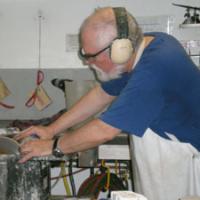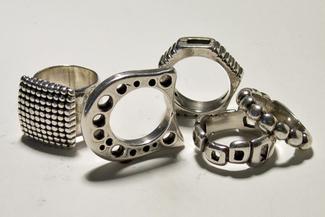Wax Working and Casting Techniques
Casting and wax working techniques can save you time and add new dimension to your artwork. Making wax models allows you create complex curves, surfaces, and textures that would be difficult and time consuming to execute in sheet metal.
Students will see wax models transformed to fully finished, one-of-a-kind pieces of silver and bronze jewelry. Skills taught include how to carve and create wax models using an alcohol lamp and simple hand tools as well as motorized flex shaft attachments. Once models are ready to cast, students will learn to sprue and invest finished wax pieces, in addition to being taught kiln burnout techniques, how to pour molten metal, and finishing methods to complete their projects. Casting methods will consist of demonstration of organic casting (cuttlefish bone and sand) and the lost wax casting process. Time permitting, students will be able to investigate organic casting methods.
Because wax working can easily be done in the comfort of your own home or small home studio setting, we will briefly discuss contract casting. Mold-making will also be discussed if time permits.
Meet the instructor

David Baird has been making jewelry for nearly four decades. He received his bachelor's degree at the Evergreen State College, and his MFA from The School of the American Craftsman at Rochester Institute of Technology. He also has a GG (Graduate Gemology certificate) from the GIA.
David sells his work nationally and has taught classes and workshops for at least 30 years around New England including Metalwerx, DeCordova Museum School, and Lexington Arts and Crafts Center. More recently he has been developing specialized jigs to make bench processes easier for his students. The Directed Open Studio courses at Metalwerx are led by David because of his vast knowledge about the many facets of metalworking.
Over the past 15 years, David has expanded his repertoire to include lapidary cabbing and carving. He now devotes his time between two studios, both lapidary and jewelry, taking on commissions by request. His studio is located at the Waltham Mill Buildings, near Metalwerx where still he teaches regularly.
Materials & Tools
The $60 materials fee, payable upon registration, includes 1 oz of sterling silver casting grain, bronze casting grain, wax, cuttlefish bone, and use of casting sand, investment, and other various supplies needed for the casting process.
Please note: Metalwerx has many of these items available for use during class but students may have to share. If you wish to bring your own, you are welcome to.
- X-acto Knife
- Old Nylons (not ones you are planning to wear again)
- Old Toothbrush (not to be re-used)
- dental tools (If you have any)
- Wood Rasp (available at Home Depot $6 - 8)
- Needle files for wax working only. Do not use the same files you use on metal.
- Sanding Sponge (available at Home Depot; 220 or 320 grit)
- Multiple grits of sandpaper for casting clean-up (320, 400, 600)
- 1 straight razor with a holder (like a paint scraper type holder)

